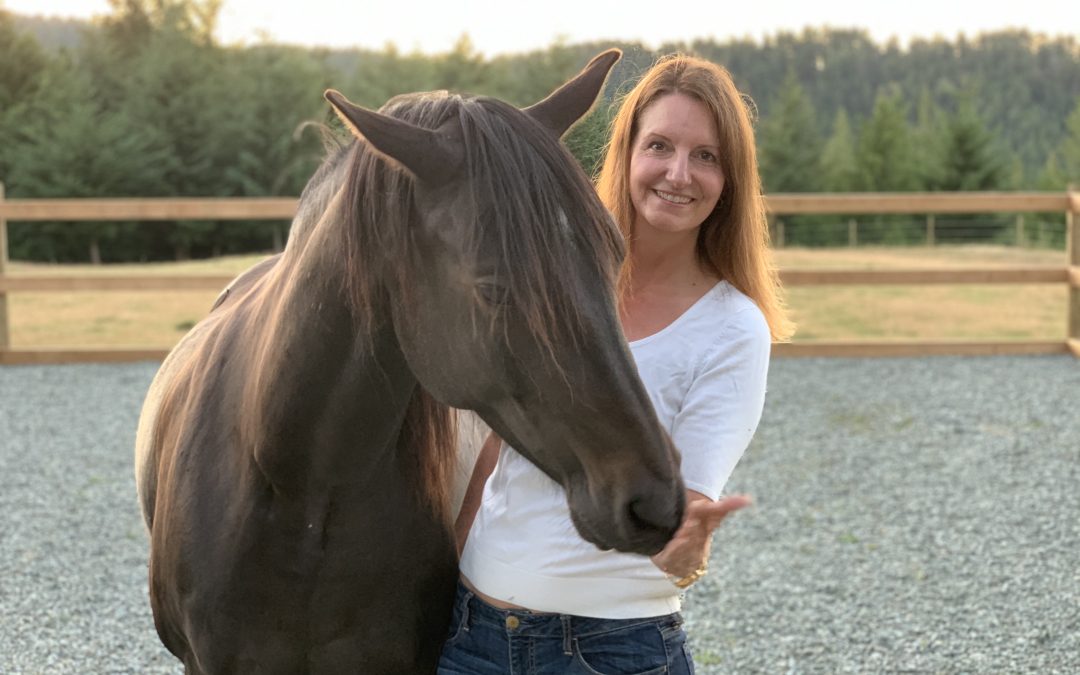Like many young girls, I rode horses in my youth but stopped around age 16. Many years later, in my mid-thirties, I rediscovered my love for horses but sought a completely different approach than in my youth, where control was emphasized over relationship.
Much later, after I moved to Canada, I bought my first own horse, a Mustang mare, Cinder, from an action as a 5-month-old foal. She was captured in Warmsprings Oregon, separated from her mother, and pretty scared when she arrived. Cinder is a fire-type personality, meaning, she is very curious, engaged, open, and fun to be around, but she is also reactive, insecure, and doesn’t have a good sense of boundaries, so from the start, she disregarded my personal space and sometimes even bumped into me. Not because she is a mean horse or wanted to hurt me, but because Fire horses are very energetic and naturally have less body awareness. However, her behavior made me feel very unsafe, especially as I only knew harsh signals to keep her away from me, so I didn’t want to use them as she was ‘just a foal’.
Sometimes I asked her ‘too friendly’ to stay out of my space when she became nervous, even though I feared she might run me over, but more often than that, I just walked away when she came too close. Why? I just wanted to build a relationship with her and didn’t dare to send her away, as she might not like me or seek closeness after a while. And being so assertive was just not someone I believed I was, and I wanted to stay ‘authentic’. When it came to training, however, I mainly used positive reinforcement, which worked great.
So, from the outside it seemed we had a very close relationship from the beginning; she was happy to see me and spend time with me. However, the problems I couldn’t solve, no matter what I tried, were how to get her to respect my personal space and how to convince her to trust and follow me in situations, where she became nervous. Just much later I learned that she definitely saw me like a mare she was friends with, but not as someone who was able to keep her safe.
Over the years, I took all sorts of courses, tried out these new ideas and approaches, and always had occasional short-term successes, but the two main problems persisted. Today, I can say of course they did. It’s so clear to me now – I tried to solve the problem where it wasn’t, by training Cinder in a different way.
But all I had to do, to change her behaviour was to change myself.
It was only when I understood why it was so hard for me to say no to her that I could let go of the search for the ultimate training method and address and heal the issue within myself. Essentially, Cinder entered my life as a substitute for a child; as my daughter grew older, the relationship naturally became less intense, so I tried to fill that gap with my love for my horse. As mentioned I bought her as a foal (the first hint of a mother-child theme) and treated her that way for the first few years.
But what I really conveyed to my horse with my “love and tolerance” was: I need you, you must be there for me, fill my gap, so I can’t say no to you because I’m afraid you won’t like me anymore, and so I’ll try to do everything you want.
What my horse concluded from this (of course not consciously, but on an emotional, energetic level) was: I should fulfill a certain role and be there for her, so I’d better keep behaving like a foal. Also, she’s very anxious when I’m near, so she’s insecure and can’t protect herself. How can she then take care of my safety? So I have to be very attentive and can only rely on myself if something dangerous happens, which seems to happen often.
What I describe here was just the beginning of a series of realizations related to my role as a mother and ultimately to my own mother and childhood.
Only after recognizing and resolving these themes could I see Cinder as a friend and part of the herd, not as a substitute child. Today, thanks to my insights into the language of wild horses, we communicate freely and naturally, but still give each other enough space.

Recent Comments